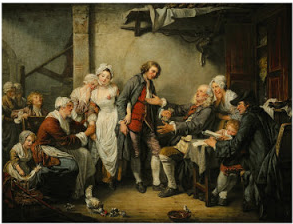By Stephanie Cowell (Regular Contributor)
 Mozart married at the age of 25 in Vienna’s Stephansdom Cathedral, where you can still go today and kneel near the spot where he knelt with his bride. He was a city man, and sophisticated, so he may not have participated in some of the usual wedding customs…but perhaps he did. Nevertheless, we do know that he set to work at once to get his bride between the sheets (what mattered in his eyes).
Mozart married at the age of 25 in Vienna’s Stephansdom Cathedral, where you can still go today and kneel near the spot where he knelt with his bride. He was a city man, and sophisticated, so he may not have participated in some of the usual wedding customs…but perhaps he did. Nevertheless, we do know that he set to work at once to get his bride between the sheets (what mattered in his eyes).
Good Fortune and Good Luck
For good fortune, the bride of the late eighteenth-century must not sew the last stitch of her wedding dress until it was time to leave for the church (we hope she remembered to remove the needle); once on her way, she must not look in a mirror. Brides on the way to marriage were considered susceptible to evil spirits. As they walked, her bridesmaids, often dressed in a similar way so that such spirits could not distinguish them from each other, clustered around her protectively. It was good luck to see a chimney sweep or a black cat. Wednesday was the most propitious day for marriages; Fridays and Saturdays were bad. If snow fell on her wedding day, it would bring fertility and wealth.
On leaving her house, the bride would step over piles of broken dishes. The night before the wedding was the Polterabend, where friends and family would small all chipped crockery or glass for good luck and hurl them out the windows.
Dressing for the Day
The wedding procession was led by a fiddler and, on the wedding morning, the bride was sent a morgen-gabe–a morning gift–from her groom. She in turn sent him a shirt she had sewn for the wedding day, which he was to keep all his life.
The bride’s dress was often white, which stood for joy, not purity; she often wore a blue band at her hem, representing purity. Her veil was another way to hide her from the spirits until safely in her husband’s care. But the first one to buy anything after the marriage would dominate the relationship; brides sometimes arranged to buy a pin from a bridesmaid. (This was before you could place an order by cell phone while walking back up the aisle.)
Weddings and Married Life
During the reception, the bride danced the wreath dance, sometimes called “dancing off the bridal crown,” the wreath which symbolized her maidenhood. Married women danced about her until their circle was broken by their fatigue or roughly intruding groomsmen, who then stole the wreath. Guests tried to take home a part of the broken wreath, which mean they would be married within the year. The bride then put a matron’s cap on her likely disheveled hair. Following the wedding, the best man would often steal the bride, leaving the groom to find her. Events could turn bawdy.
After marriage, a woman’s life would consist of kinder, kleider, kirche, and kuche–children, clothes, church, and cooking. Of course, for many women, there was much more than that.
While we may not know how many of these traditions Mozart and his wife engaged in, we do know that their marriage was a joyful one despite their being poor. His love letters during their married life are tender, bawdy, and filled with the greatest love.
This post originally appeared at Wonders & Marvels on 18 December 2008.
